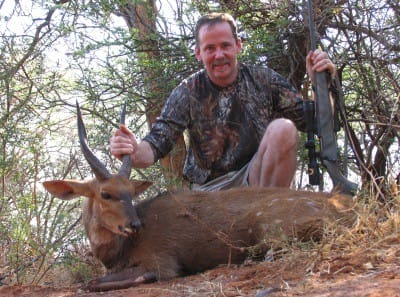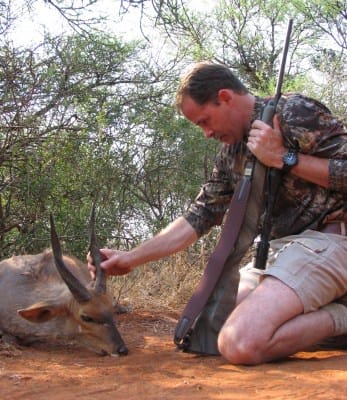
On my first African safari I shot the first bushbuck I saw. From talking with other hunters, that’s not extremely unusual.
Unlike most African plains game, the bushbuck is a not a herd animal. In one day you may see 100 wildebeest or 200 impala but if you see one bushbuck you are lucky and if you want one on your wall, don’t wait around all day to pull the trigger. The elusiveness and difficulty associated with finding bushbuck as well as the respect professional hunters give them intrigued me. “Not easy, the bushbuck,” they would say.
Bushbuck may be one of the most overlooked of all African trophies. I imagine this is somewhat due to the fact they are small (the average bushbuck is about the size of a south Texas whitetail doe) and somewhat because, compared to the horns of other African plains game of the spiral horn variety, bushbuck horns are short. But don’t think for a minute this makes them easy. While most hunters can connect with a nice representative of the species during a seven to 10 day safari, it will require some effort. You don’t just look over a heard of bushbuck and pick out the one you want.
Last year, while hunting with Lyon Safaris , I was on a magnificent concession operated by Camel Thorn Hunting Safaris near Thambazimbi. It is one of the largest concessions in South Africa. We were looking for bushbuck or bushbuck sign while riding in the back of a Land Rover Defender. As we motored along beside a lake my guide, Casper Le Roux, spotted a male and female bushbuck near water’s edge. Casper suggested we pull the Land Rover into the brush and that I try to stalk the male.

We parked, I climbed out of the truck and cautiously started down the road looking for a spot to slip into the thorn bush. What none of us knew was that the bushbuck had already been spooked.
I hadn’t gone 20 steps when he burst into the road about 40 yards in front of me headed for the thick stuff. From the truck Casper yelled, “Very nice bushbuck!” Knowing how difficult it is to locate a trophy bushbuck and given this was my last day to hunt, I shouldered the rifle, found the buck in the Trijicon scope and applied what I thought was a proper lead. The rifle cracked just as the little antelope was leaving the road. He disappeared into the brush.
“That was quick shooting but I think you missed,” Casper said.
“Maybe,” I said. “The shot felt good.”
We walked up the road and found the bushbuck’s tracks. We found blood too. ‘You hit him,” Casper said. “I would have bet money you missed.”
“Yeah, I hit him but can we find him?” I asked. Standing over the tracks and the few drops of blood I looked into the vastness of the brush I began to think I shouldn’t have risked a shot.
In Africa, if you draw blood you pay the trophy fee for the animal you shoot regardless if it is found or not. The brush was incredibly thick limiting visibility to about 20 yards and I was concerned. Not just about being able to find the bushbuck but also because they are notorious for being dangerously aggressive when wounded.
We spread out looking for spoor. After about 15 minutes I heard a bark. Bushbuck make a sharp bark like you would hear from a medium sized dog. It bark came from near Casper who was about 50 yards to my left. I rushed over and found him hunkered down, pointing into the brush. “See him?” Casper whispered.
“Yeah. I got him.”
I shot immediately and the buck, crouching low, ran to our right and piled up after about 30 yards. He was down but not done and as we approached he tried to get on his feet to come at us. A third Nosler Partition ended it. The first shot hit too far forward as the buck was quartering away and it broke the left front leg. The second shot, at a quartering away angle from the opposite side, passed diagonally through one lung. The third and final shot applied as the buck was down on his side pierced the heart and lodged in the spine.
That was my last day of hunting and just like during my first safari I shot the first bushbuck I saw. That may not be the best advice to give a bushbuck hunter but it has worked for me—two years in a row.
Contact:
Camel Thorn Hunting Safaris;www.camelthorn.co.za/home.htm
Lyon Safaris; www.lyonsafaris.com




